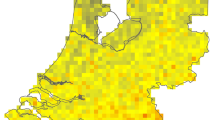Abstract
Background
This paper applies a method for modelling the spatial variation of West Nile virus (WNv) in humans using bird, environmental and human testing data.
Methods
We used data collected from 503 Alberta municipalities. In order to manage the effects of residual spatial autocorrelation, we used generalized linear mixed models (GLMM) to model the incidence of infection.
Results
There were 275 confirmed cases of WNv in the 2003 calendar year in Alberta. Our spatial model indicates that living in the grasslands natural region and levels of human testing are significant positive predictors of WNv; living in an urban area is a significant negative predictor.
Conclusion
Infected bird data contribute little to our model. The variability of West Nile virus incidence in Alberta may be partly confounded by the variations in the rate of testing in different parts of the province. However, variation in infection is also associated with known environmental risk factors. Our findings are consistent with existing knowledge of WNv in North America.
Résumé
Contexte
Dans cet article, nous appliquons une méthode de modélisation de la variation spatiale du virus du Nil occidental (VNO) chez les humains à l’aide de données d’essais sur les oiseaux, l’environnement et les humains.
Méthode
Nous avons utilisé des données recueillies auprès de 503 municipalités de l’Alberta. Pour atténuer les effets de l’autocorrélation spatiale résiduelle, nous avons fait appel à des modèles linéaires généralisés mixtes (GLMM) pour modéliser l’incidence de l’infection.
Résultats
Il y a eu 275 cas confirmés de VNO en Alberta au cours de l’année civile 2003. Notre modèle spatial montre que le fait de vivre dans la région naturelle des prairies et l’envergure des essais sur les humains sont d’importants prédicteurs positifs du VNO; le fait de vivre en milieu urbain est quant à lui un important prédicteur négatif.
Conclusion
Les données sur les oiseaux infectés jouent peu dans notre modèle. L’envergure variable des essais à différents endroits de la province pourrait être un facteur confusionnel dans la variabilité de l’incidence du virus du Nil occidental en Alberta. Cependant, les écarts dans les taux d’infection sont aussi associés à des facteurs de risque environnementaux connus. Nos constatations sont compatibles avec les connaissances actuelles sur le VNO en Amérique du Nord.
Similar content being viewed by others
References
Sayao A, Suchowersky O, Al-Khathaami A, Klassen B, Katz NR, Sevick R et al. Calgary experience with West Nile virus neurological syndrome during the late summer of 2003. Can J Neurol Sci 2004;31:194–203.
Weir E, Shapiro H. West Nile virus: Round five. CMAJ 2004;170:1669–1670.
Power C, van Marle G. The emergence of West Nile virus in Canada. Can J Neurol Sci 2004;31:135–137.
Hayes EB, Komar N, Nasci RX, Montgomery SP, O’Leary DR, Campbell GL. Epidemiology and transmission dynamics of West Nile virus disease. Emerg Infect Dis 2005;11:1167–1173.
Turell MJ, O’Guinn ML, Dohm DJ, Jones JW. Vector competence of North American mosquitoes (Diptera: Culicidae) for West Nile virus. J Med Entomol 2001;38:130–134.
Sardellis MR, Turell MJ, Dohm DJ, O’Guinn ML. Vector competence of selected North American Culex and Coquillettidia mosquitoes for West Nile virus. Emerg Infect Dis 2001;7:1018–1022.
Turell MJ, Dohm DJ, Sardelis MR, O’Guinn ML, Andreadis TG, Blow JA. An update on the potential of North American mosquitoes (Diptera: Culicidae) to transmit West Nile virus. J Med Entomol 2005;42:57–62.
Darsie RF, Ward RA. Identification and Geographical Distribution of the Mosquitoes of North America, North of Mexico. Gainesville FL: University Press of Florida, 2005;225–340.
Johnson GD, Eidson M, Schmit K, Ellis A, Kulldorff M. Geographic prediction of human onset of West Nile virus using dead crow clusters: An evaluation of year 2002 data in New York State. Am J Epidemiol 2005;163:171–180.
Gibbs SEJ, Wimberly MC, Madden M, Masour J, Yabsley MJ, Stallknecht DE. Factors affecting the geographic distribution of West Nile virus in Georgia, USA: 2002–2004. Vector-Borne and Zoonotic Diseases 2006;6:73–82.
Alberta Municipal Affairs. Municipal Government Act. Available online at: https://doi.org/www.qp.gov.ab.ca/documents/Acts/M26.cfm?frm._isbn= 0779737822&type=htm (Accessed August 3, 2005).
Mostashari F, Bunning ML, Kitsutani PT, Singer DA, Nash D, Cooper MJ et al. Epidemic West Nile encephalitis, New York, 1999: Results of a household-based seroepidemiological survey. Lancet 2001;358:261–264.
Reisen WK, Lothrop HD. Population ecology and dispersal of Culex Tarsalis (Diptera, Culcidae) in the Coachella Valley of California. J Med Entomol 1995;32:490–502.
Alberta Sustainable Resource Development, Alberta Environment, Alberta Community Development and Agriculture and Agri-Food Canada. Natural Regions and Subregions of Alberta, 2005. Available online at: https://doi.org/www.cd.gov.ab.ca/preserving/parks/anhic/download._data.asp (Accessed July 27, 2005).
Bailey TC, Gatrell AC. Interactive Spatial Data Analysis. Essex, England: Longman Scientific & Technical, 2005.
Bartlett MS. The spectral analysis of two-dimensional point processes. Biometrika 1964;51;299–311.
Littell RC, Milliken GA, Stroup WW, Wolfinger RD. SAS System for Mixed Models. Cary, NC: SAS Institute Inc., 1996;303–320.
Kleinschmidt I, Sharp BL, Clarke GPY, Curtis B, Fraser C. Use of generalized linear mixed models in the spatial analysis of small-area malaria incidence rates in KwaZulu Natal, South Africa. Am J Epidemiol 2001;153:1213–1221.
Waller LA, Gotway CA. Applied Spatial Statistics for Public Health Data. Hoboken, NJ: John Wiley & Sons Inc., 2004;380–409.
Alberta Health & Wellness 2004. West Nile virus Infection Rate Study. Available online at: https://doi.org/www.health.gov.ab.ca/public/wnv._bloodsurvey.pdf (Accessed July 25, 2005).
Forand SP, Talbot TO, Druschel C, Cross PK. Data quality and the spatial analysis of diseaserates: Congenital malformations in New York State. Health and Place 2002;8:191–199.
Murray CJL, Lopez AD. Estimating causes of death: New methods and global and regional applications for 1990. In: Murray CJL, Lopez AD (Eds.), The Global Burden of Disease 1996. Geneva: World Health Organization, 1996; Chapter 3.
Yiannakoulias N, Svenson LW, Schopflocher DP. Commentary: Diagnostic uncertainty and medical geography: What are we mapping? The Canadian Geographer 2005;49:291–300.
Horsfall WR. Mosquitoes: Their Bionomics and Relation to Disease. New York, NY: The Ronald Press Company, 1955;547–598.
Author information
Authors and Affiliations
Corresponding author
Rights and permissions
About this article
Cite this article
Yiannakoulias, N.W., Schopflocher, D.P. & Svenson, L.W. Modelling Geographic Variations in West Nile Virus. Can J Public Health 97, 374–378 (2006). https://doi.org/10.1007/BF03405345
Received:
Accepted:
Published:
Issue Date:
DOI: https://doi.org/10.1007/BF03405345




